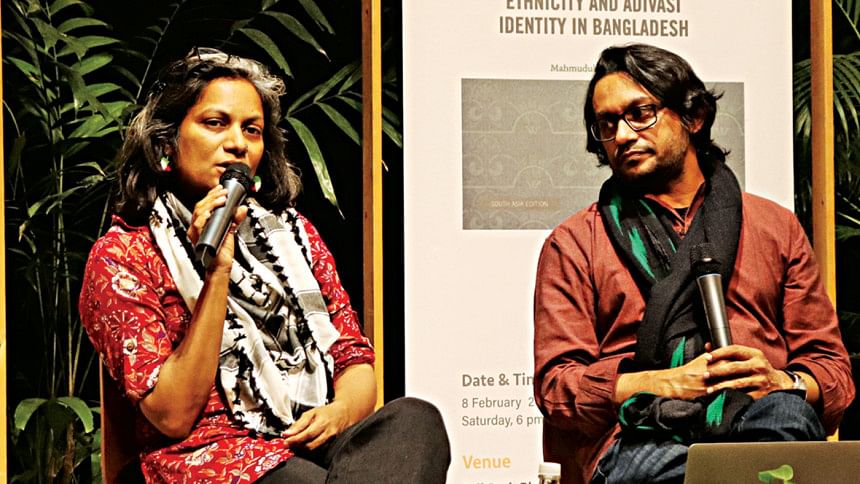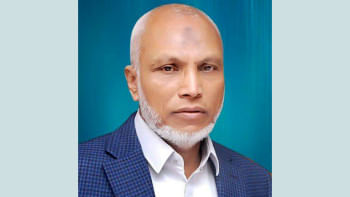The space for indigeneity: Discussing ‘Ethnicity and Adivasi Identity in Bangladesh’

The recognition of indigenous citizens and their rights has been a point of contention in Bangladeshi politics for quite some time. It gained more traction after August 5, once Sheikh Hasina was ousted and the hope for a new Bangladesh where all ethnic and religious identities would live with dignity was reignited. This served as the backdrop for the book talk on Ethnicity and Adivasi Identity In Bangladesh by Mahmudul H Sumon, which was held at DrikPath Bhobon on February 8, 2025. The discussion panel included the author himself and journalist Saydia Gulrukh.
The talk commenced with Saydia Gulrukh introducing the book, which has gained renewed relevance in the present as the subject of indigenous rights sparked nationwide discussion. She talked about the modern state and the conspiratorial role it assigns to groups of people it marks as "enemies", providing examples of the Bawm people facing systemic subjugation under that conspiratorial narrative. She expanded on how the new political establishment seems to exclude indigenous citizens not only in violent ways, such as the attack on indigenous activists on January 15, but also in non-violent ways, such as reform commissions not actively engaging with indigenous people.
Following her introduction, author Mahmudul H Sumon discussed indigenous activism, which he categorised as a type of "politics of recognition" that can be traced back to the 90s. He shared his own experiences of getting to know indigenous activists during this period and observing how the movement for indigenous recognition took shape.
He realised that academic discussions surrounding indigenous people often took a much more romantic and aestheticised tone, which was both unhelpful and ahistorical. Therefore, he wanted to theorise and historicise it, focusing on how previous colonialism and its view of indigenous people affected them. He also wanted to look into how indigenous activists are reclaiming their own heritage and history through their work. According to the author, Ethnicity and Adivasi Identity In Bangladesh is about all indigenous people in Bangladesh, whether they resided in the plain or the hills.
Afterwards, the author elaborated on the book's five chapters and what each dealt with. Discussing the first chapter, which is about transnational governmentality and adivasi subjectivity, Mahmudul H Sumon dove into what he called the "transnational discourse of indigeneity"—how indigenous activism sprang up worldwide and how the global movement has affected debates about indigeneity, colonisation, land dispossession, etc., transcending national borders. Anthropological studies have both shaped and been shaped by this discourse.
The second chapter deals with the colonial archive and its effects, covering topics such as the CHT Manual enacted in the British period and how it protected the hill tracts at that time. He also brought up the systemic dispossession of indigenous communities such as the Garo from Madhupur and Shalban, which is an often neglected issue in indigenous discourse.
The reclamation of the identity of Adivasi as their own forms the basis of the third chapter. This includes debates surrounding the recognition of Adivasi or indigenous identity under the clauses 107 and 169 of ILO, which grants a certain set of special privileges to the community, including the protection of their habitat and customs. The fourth focuses on a very specific festival as a part of this reclamation—Wanna or Wangala, which has seen a revival through activism in recent times.
The final chapter poses a heavy question: Do Adivasis exist? Despite the misconception many Bangalis hold about the word, and repeated denials of Adivasi identity on a national stage (such as when former Foreign Minister Dipu Moni said that Adivasis don't exist in Bangladesh), the author concluded that Adivasis do, in fact, exist. This conversation recalled the previous discussion on the transnational discourse of indigeneity.
Next, Sumon emphasised the role of the government in finding solutions to these problems, and pointed out that the government has, so far, been reluctant to initiate or enter a dialogue on the issue. He mentioned that the denial of indigenous identity and rights has only strengthened the movement more. Bangali nationalism was also discussed, considering its role in the subjugation of indigenous peoples in the Chittagong Hill Tracts.
After this session, the floor was opened to the audience for questions. Questions ranged from the lack of female and working class activists in the formation of Bangali identity, to the geopolitical reasons which are often brought up to justify denying recognition to indigenous people. The lack of indigenous people in the discussion panel was also questioned, and both Gulrukh and Sumon expressed that this was a limitation on their part.
The questions surrounding indigenous citizens continue to be complex, as do their answers. It can get easier, but until the state volunteers to come forward and have a meaningful and genuine conversation, progress will not be possible. Discussions such as these are important steps in getting there, and it must include more representatives from indigenous communities themselves. It is hoped that their struggles will pay off in a post-July Bangladesh, which held the principles of equality and justice as its leading force.
Sadman Ahmed Siam, as the name suggests, is indeed a sad man. Send him happy quotes at: [email protected].

 For all latest news, follow The Daily Star's Google News channel.
For all latest news, follow The Daily Star's Google News channel. 



Comments